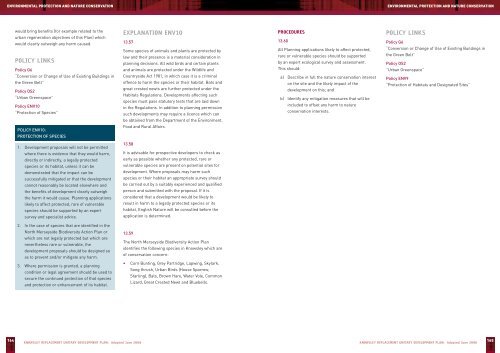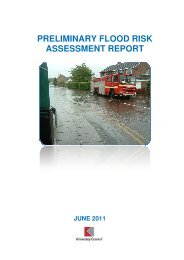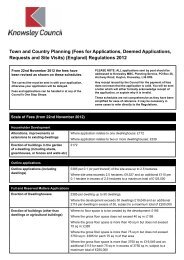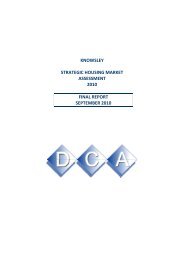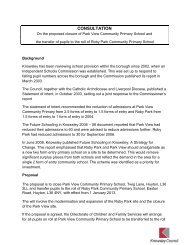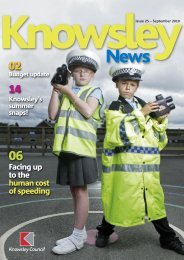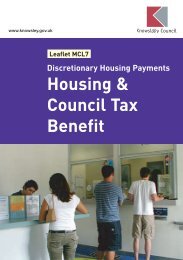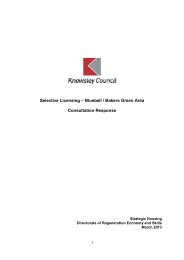Knowsley Replacement Unitary Development Plan - Knowsley Council
Knowsley Replacement Unitary Development Plan - Knowsley Council
Knowsley Replacement Unitary Development Plan - Knowsley Council
You also want an ePaper? Increase the reach of your titles
YUMPU automatically turns print PDFs into web optimized ePapers that Google loves.
ENVIRONMENTAL PROTECTION AND NATURE CONSERVATION<br />
ENVIRONMENTAL PROTECTION AND NATURE CONSERVATION<br />
would bring benefits (for example related to the<br />
urban regeneration objectives of this <strong>Plan</strong>) which<br />
would clearly outweigh any harm caused.<br />
POLICY LINKS<br />
Policy G6<br />
“Conversion or Change of Use of Existing Buildings in<br />
the Green Belt”<br />
Policy OS2<br />
“Urban Greenspace”<br />
Policy ENV10<br />
“Protection of Species”<br />
POLICY ENV10:<br />
PROTECTION OF SPECIES<br />
EXPLANATION ENV10<br />
13.57<br />
Some species of animals and plants are protected by<br />
law and their presence is a material consideration in<br />
planning decisions. All wild birds and certain plants<br />
and animals are protected under the Wildlife and<br />
Countryside Act 1981, in which case it is a criminal<br />
offence to harm the species or their habitat. Bats and<br />
great crested newts are further protected under the<br />
Habitats Regulations. <strong>Development</strong>s affecting such<br />
species must pass statutory tests that are laid down<br />
in the Regulations. In addition to planning permission<br />
such developments may require a licence which can<br />
be obtained from the Department of the Environment,<br />
Food and Rural Affairs.<br />
PROCEDURES<br />
13.60<br />
All <strong>Plan</strong>ning applications likely to affect protected,<br />
rare or vulnerable species should be supported<br />
by an expert ecological survey and assessment.<br />
This should:<br />
a) Describe in full the nature conservation interest<br />
on the site and the likely impact of the<br />
development on this; and<br />
b) Identify any mitigation measures that will be<br />
included to offset any harm to nature<br />
conservation interests.<br />
POLICY LINKS<br />
Policy G6<br />
“Conversion or Change of Use of Existing Buildings in<br />
the Green Belt”<br />
Policy OS2<br />
“Urban Greenspace”<br />
Policy ENV9<br />
“Protection of Habitats and Designated Sites”<br />
1. <strong>Development</strong> proposals will not be permitted<br />
where there is evidence that they would harm,<br />
directly or indirectly, a legally protected<br />
species or its habitat, unless it can be<br />
demonstrated that the impact can be<br />
successfully mitigated or that the development<br />
cannot reasonably be located elsewhere and<br />
the benefits of development clearly outweigh<br />
the harm it would cause. <strong>Plan</strong>ning applications<br />
likely to affect protected, rare of vulnerable<br />
species should be supported by an expert<br />
survey and specialist advice.<br />
13.58<br />
It is advisable for prospective developers to check as<br />
early as possible whether any protected, rare or<br />
vulnerable species are present on potential sites for<br />
development. Where proposals may harm such<br />
species or their habitat an appropriate survey should<br />
be carried out by a suitably experienced and qualified<br />
person and submitted with the proposal. If it is<br />
considered that a development would be likely to<br />
result in harm to a legally protected species or its<br />
habitat, English Nature will be consulted before the<br />
application is determined.<br />
2. In the case of species that are identified in the<br />
North Merseyside Biodiversity Action <strong>Plan</strong> or<br />
which are not legally protected but which are<br />
nevertheless rare or vulnerable, the<br />
development proposals should be designed so<br />
as to prevent and/or mitigate any harm.<br />
3. Where permission is granted, a planning<br />
condition or legal agreement should be used to<br />
secure the continued protection of that species<br />
and protection or enhancement of its habitat.<br />
13.59<br />
The North Merseyside Biodiversity Action <strong>Plan</strong><br />
identifies the following species in <strong>Knowsley</strong> which are<br />
of conservation concern:<br />
• Corn Bunting, Grey Partridge, Lapwing, Skylark,<br />
Song thrush, Urban Birds (House Sparrow,<br />
Starling), Bats, Brown Hare, Water Vole, Common<br />
Lizard, Great Crested Newt and Bluebells.<br />
164<br />
KNOWSLEY REPLACEMENT UNITARY DEVELOPMENT PLAN: Adopted June 2006<br />
KNOWSLEY REPLACEMENT UNITARY DEVELOPMENT PLAN: Adopted June 2006<br />
165


